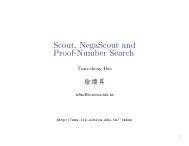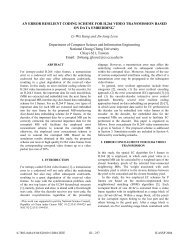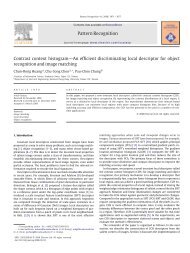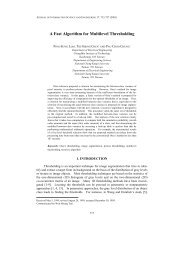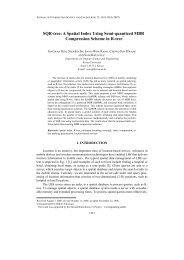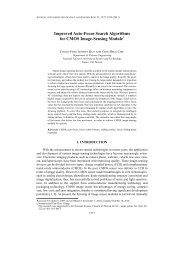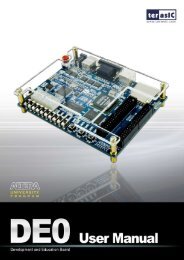Design, Implementation, and Performance Evaluation of Flash ...
Design, Implementation, and Performance Evaluation of Flash ...
Design, Implementation, and Performance Evaluation of Flash ...
Create successful ePaper yourself
Turn your PDF publications into a flip-book with our unique Google optimized e-Paper software.
FLASH MEMORY-BASED FILE SYSTEM ON CHIP<br />
vice <strong>and</strong> the FSOC increases very slowly, looking almost as if they are constant, with the<br />
FSOC increasing even slower as more file/storage activities are performed in the storage<br />
device, which has a slower CPU.<br />
When the initial value is over 15000, things start to change in the conventional storage<br />
device. Now, all the computation time cannot be hidden behind the I/O time <strong>and</strong> the<br />
computation time starts to dictate the application run time. Hence, as the computation<br />
time increases, the total execution time increases with it. For FSOC, since its I/O time is<br />
greater than that <strong>of</strong> the conventional storage device, the above phenomenon does not<br />
occur until the counter variable reaches 17000. Between 15000 <strong>and</strong> 17000, the execution<br />
time <strong>of</strong> FSOC remains almost constant while that <strong>of</strong> the conventional storage device increases<br />
linearly. Hence, before the two crosses over (in our case this happens when the<br />
counter variable value reaches 16000), the conventional storage device performs better,<br />
while after the crossover point, the FSOC starts to perform better. Beyond 17000, both<br />
devices are dominated by the computation time <strong>and</strong> so the difference in performance<br />
remains constant with FSOC performing better.<br />
Fig. 11 (b) compares Fig. 11 (a), the results obtained through actual measurements<br />
<strong>and</strong> Fig. 7, which shows the values obtained from the model. The parameters used for the<br />
model were obtained from actual measurements 2 . Observe the similarity between the<br />
results. The margin <strong>of</strong> error is in the 2-3% range. The error comes from the extra overhead<br />
caused by executing measurement code. When we calibrated the parameters by<br />
subtracting measurement overhead, the margin <strong>of</strong> error was reduced below 1%. These<br />
results experimentally validate the presented performance model for the case where I/O<br />
processing <strong>and</strong> computation may be executed in parallel.<br />
5.2 Computing Power <strong>of</strong> the Host <strong>and</strong> the Storage Device<br />
Portable storage devices such as the FSOC can be used with diverse hosts, <strong>and</strong> the<br />
execution time <strong>of</strong> the application code <strong>and</strong> the file system code varies depending on the<br />
computing power <strong>of</strong> the host. In this section, we analyze the influence <strong>of</strong> the computing<br />
power <strong>of</strong> the host <strong>and</strong> the storage devices on the application performance. For this purpose,<br />
we execute the synthetic workload described in section 5.1 with various host clock<br />
speeds.<br />
Fig. 12 shows the experimental results for host clock speeds <strong>of</strong> 45MHz, 56MHz,<br />
<strong>and</strong> 67MHz, while the clock speed <strong>of</strong> the storage device core remains fixed at 24Mhz.<br />
Notice that the crossover point where the FSOC starts to perform better than the conventional<br />
storage device moves to the right as the clock speed increases. This is a natural<br />
consequence as with a faster clock more computation can be hidden behind the I/O time.<br />
Except for this, we can observe the same performance trends as in Fig. 11 (a).<br />
We also performed experiments with three real-world applications: cat, gzip, <strong>and</strong><br />
mpeg. The versions that we used were cat that is embedded in busybox 0.60.3, gzip 1.3.2<br />
from GNU, mpeg2play 1.1 from MPEG S<strong>of</strong>tware Simulation Group. Cat dumps the contents<br />
<strong>of</strong> a 1MB file on the terminal, gzip compresses a file whose original size is 4.8MB,<br />
2 We obtained the actual execution time by inserting measurement instructions into the device driver, stub, <strong>and</strong><br />
the file system code. TFS_host is measured by recording timestamps at the entry <strong>of</strong> the file system code <strong>and</strong> the<br />
device driver code in the host, <strong>and</strong> calculating the difference. TFS_FSOC is measured by similar method, recording<br />
timestamps at the entry <strong>of</strong> the file system code <strong>and</strong> the flash memory access code in the storage device.<br />
1879



